
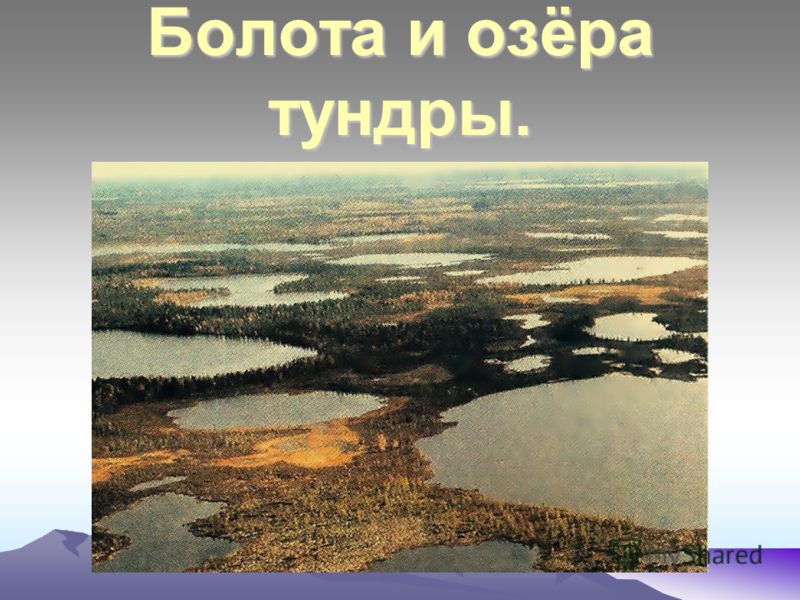
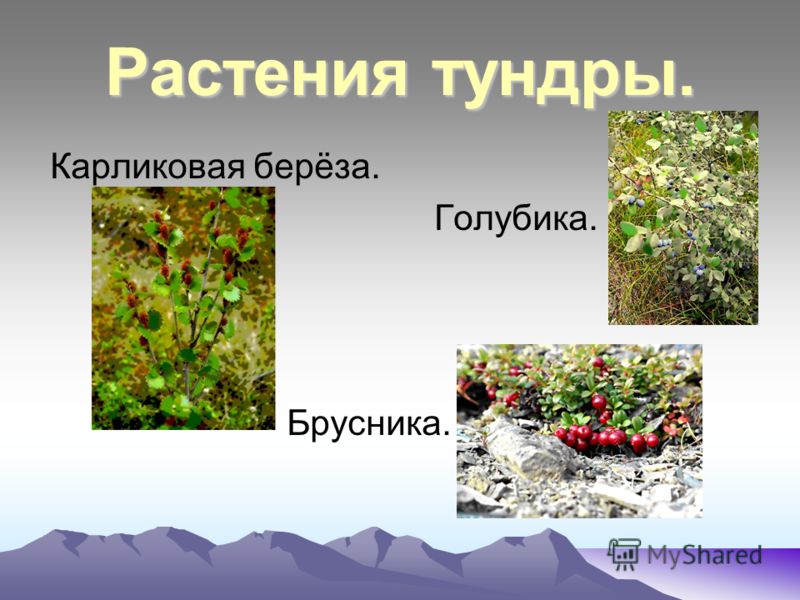
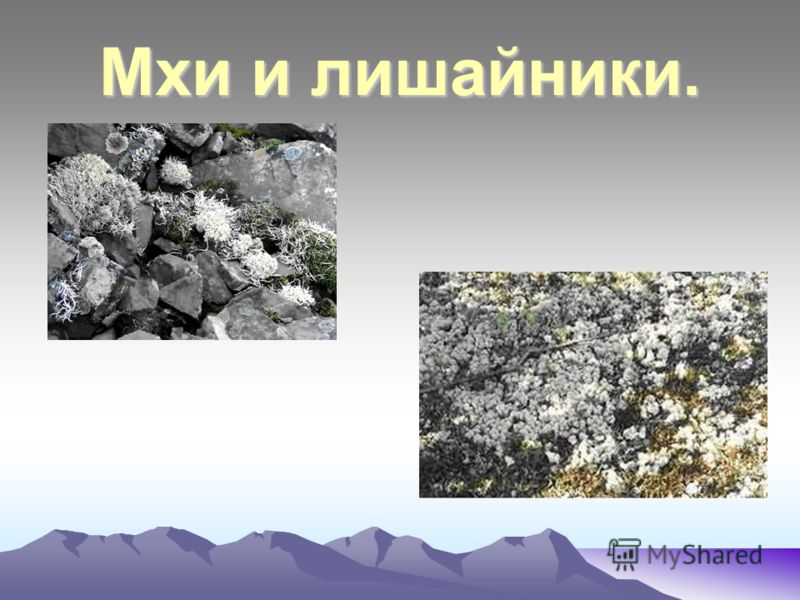
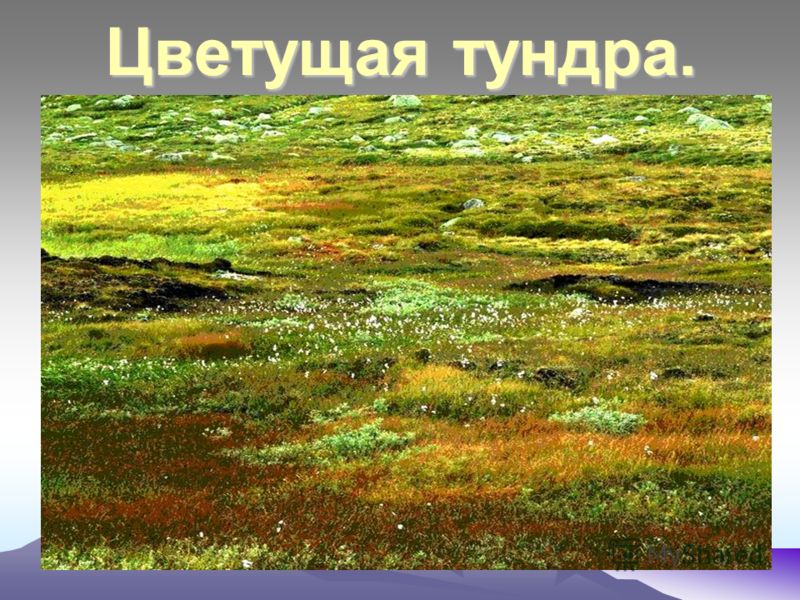
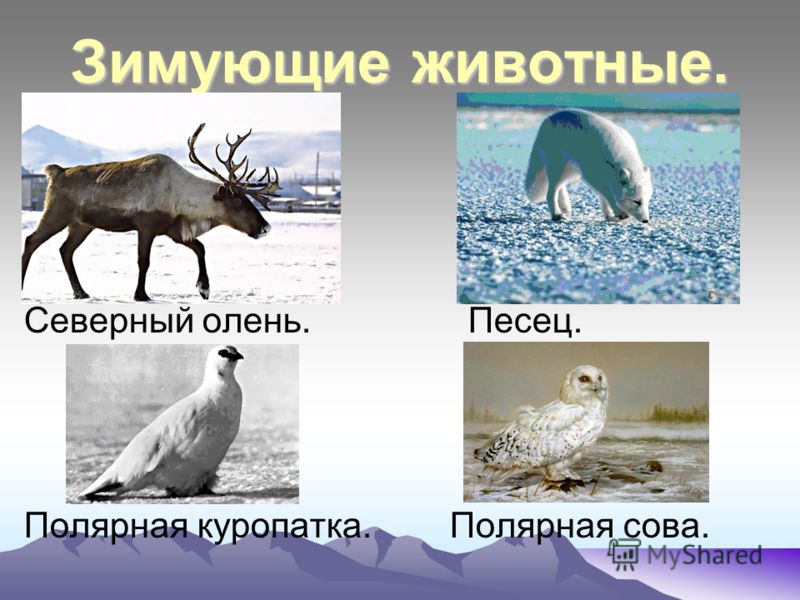
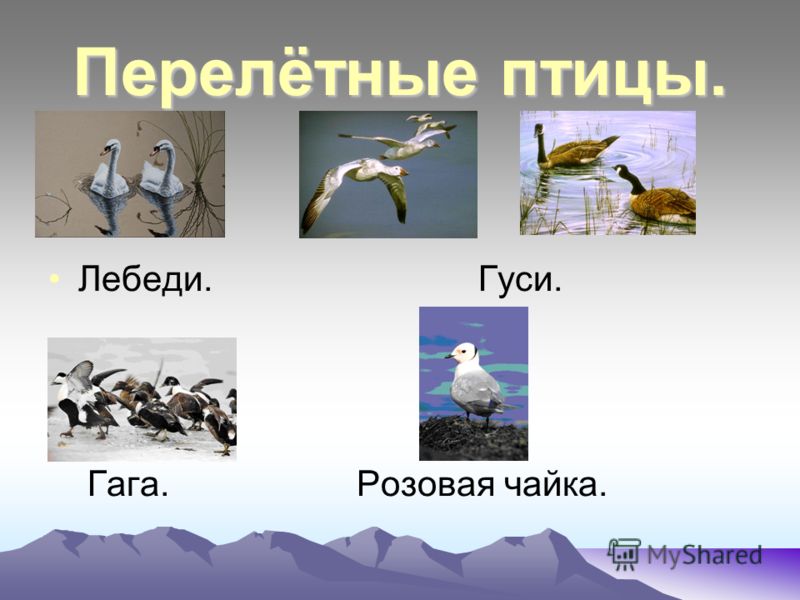
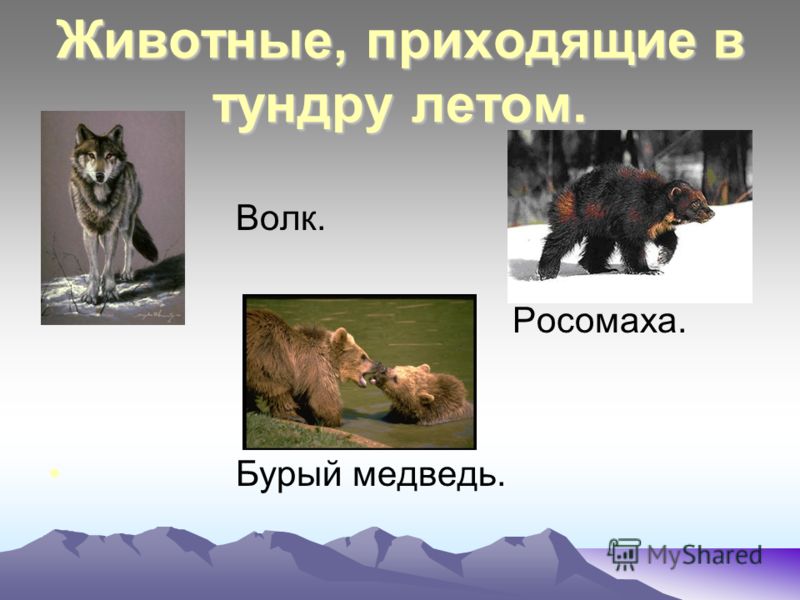
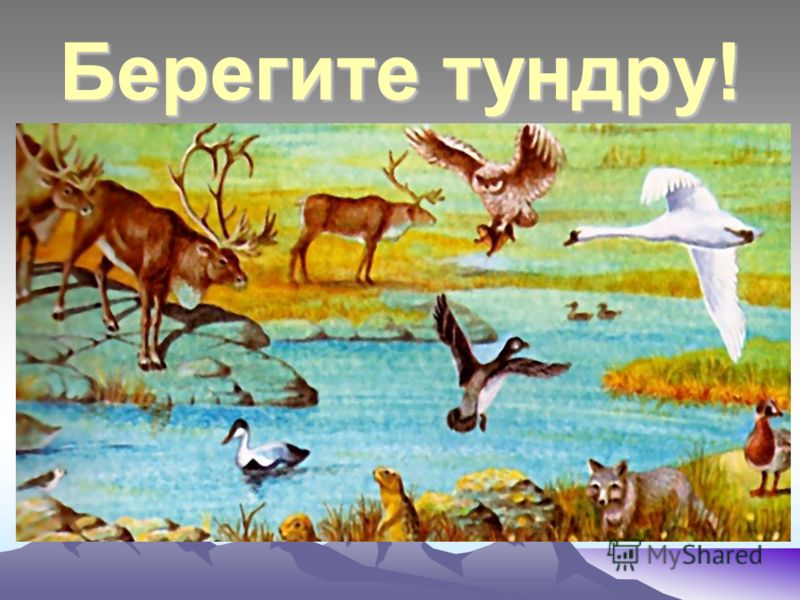
In the north of Eurasia there is a special natural zone - tundra. The name comes from the Finnish word "tanturi", which translates as "treeless hill". Tundras are within the subarctic climate zone. The sun does not appear in a long, harsh winter for several weeks. It is a cold polar night. The temperature drops below -50 degrees Celsius. Snow falls a little, and the ground freezes over. Often strong winds blow. Summer in these areas is short and cold. Even in July, the air temperature rarely exceeds +10 degrees. In the middle of summer there are often frosts and snowfalls. There is little precipitation in the tundra, but due to low temperatures the water does not evaporate, but remains in the soil. Much of the tundra is marshy.
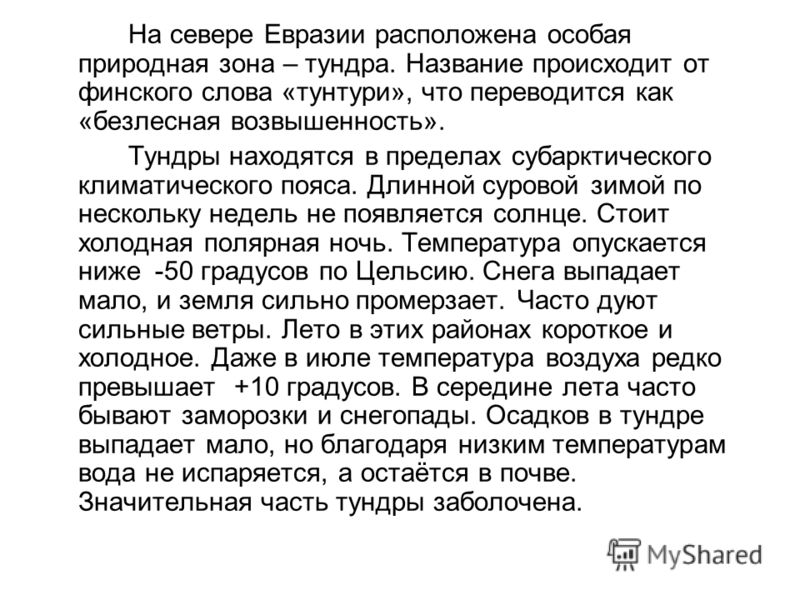
Conditions for plant and animal life in the tundra are extremely unfavorable. Only a few species have adapted to the harsh climate of the northern natural zone. Tundra plants grow very slowly, for example, polar willow grows by only 1–5 mm in a year, and a tree 1 cm thick may turn out to be 100 years old. In the tundra, dwarf willows and birches are only 20–30 cm high. Tundra is the kingdom of mosses and lichens. There are more than 800 species here. Also in the tundra there are various types of grasses and shrubs. Among the shrubs there are a lot of plants with edible berries: lingonberries, blueberries, crowberries, bearberry and others. Their leaves are small, narrow, covered like wax. Unusually beautiful nature of the tundra in the summer. White and pink dryads and primroses bloom in the tundra, yellow poppies and buttercups rise above them, islands of blue forget-me-nots are scattered around the tundra.
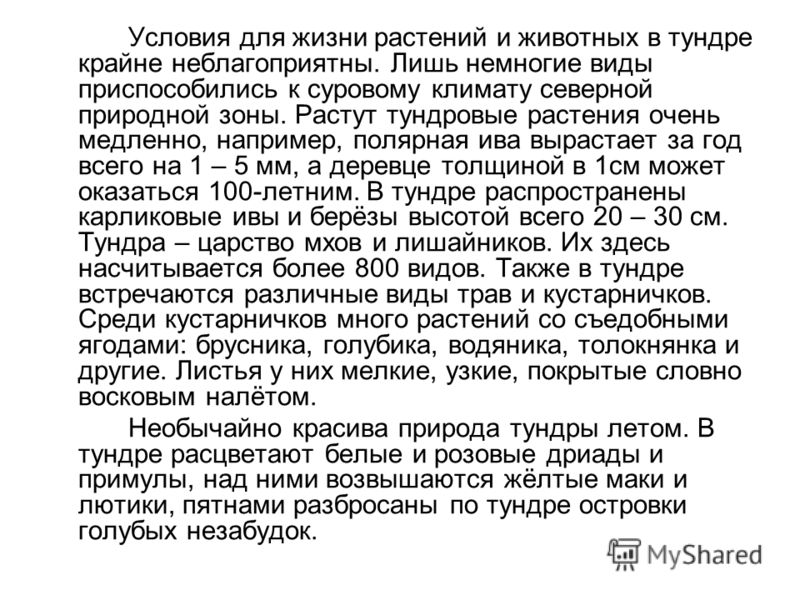
Few animal species can live in the harsh conditions of the tundra. Most of the animals migrate to the taiga for the winter, and birds fly to warm countries. Reindeer live in the tundra all year round, white foxes - arctic foxes, white partridges and polar owls. In the summer, a huge number of insects - mosquitoes and midges appear on lakes and swamps. Waterfowl feed on them: swans, geese, geese, sandpipers, eiders. Only in the tundra you can find a rare pink tea. In summer, hares, wolves, and wolverines return from the taiga to the tundra. Often goes on the berries of a brown bear.
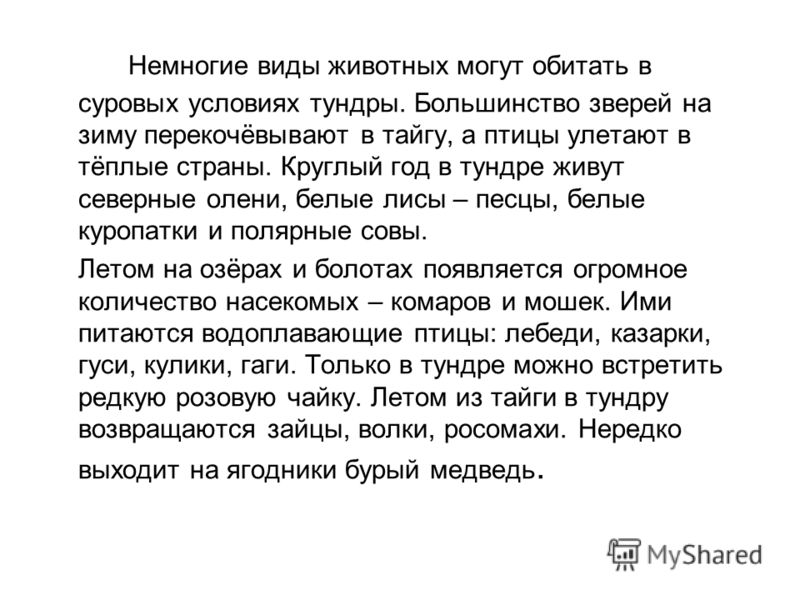

"Nature of the Tundra" - A remarkable inhabitant of the tundra - a wild reindeer. In winter, the snowstorm rages on for many days. The deer are followed by wolves who prey on the sick, who have strayed from the herd of animals. Summer is short and cool. In the summer there are many mosquitoes and midges in the tundra. Seasons in the tundra. The nature of the tundra is harsh. There are a lot of different mosses in the tundra.
"Tundra Zone" - In the tundra, a very large number of blood-sucking insects. The plants are low. The tundra is located south of the ice zone of the Arctic. The destruction of one of the links of the chain leads to the death of the entire natural community. Frosts in the tundra last from 8 to 9 months, the temperature in the tundra sometimes reaches -52 ° C. Due to the poor natural conditions of the tundra, the population is few.
“Natural zone Tundra” - Climatic zone. The abundance of moisture is the result of low evaporation. In places of deeper thawing there are shallow hollows filled with water. Economic use and problems of violation of the integrity of the PC. Rivers in the summer are plenty. Natural zonality. Plan for the study of the natural area:
“Tundra geography” - Rivers and lakes are rich in fish (nelma, chir, omul, whitefish and others). Content. By the nature of the surface of the tundra are swampy, peaty, stony. The tundra is located north of the taiga zone. Title. Information sources. Animal World tundra. Around sedge-cotton grass lakes with a small admixture of herbs and grasses.
"Tundra 8 class" - Environmental problems. Soils of the tundra zone. Road trains move along the tundra, leaving behind trash and destroying vegetation cover. Tundra zone. Due to the leakage of fuel from oil pipelines, the surrounding territory is polluted, often burning oil lakes and completely burnt areas, once covered with vegetation, are encountered.
“The Tundra of the World” - In addition to reindeer herding, the population is engaged in hunting and fishing. White Crane (Siberian Crane). The population density in the tundra is small: less than 1 person per 1 square. km Musk ox Plantain. Tundra swan. In summer, waterfowl nest in the tundra. In the spring, permafrost prevents meltwater from seeping deep into.
All this creates special conditions for animals living in the tundra.
In the summer in the tundra a huge number of insects. Among them are the most mosquitoes and black flies. Their swarms are covered, their hands are climbing under their clothes. In the air, whole swarms of flies, gadflies and. These are the scourge of the reindeer herding. Occasionally can be found in the tundra and butterflies. By the end of the polar insects disappear.
The weather in the tundra is very changeable. In July there are hot days, the air temperature reaches 25 °. But the hot weather suddenly gives way to cold. In the open spaces of the tundra strong winds are walking, at night it drops to + 4 ° It often drizzles rain.
The birds, in spite of the short summer and summer cold snaps, have time to sit and feed the chicks in the autumn cold weather. In summer, the sun and the tundra shine round, and therefore the birds have much more time for chicks to catch than, say, in the middle lane. On and they spend less time. In addition, in the north, much more UV rays penetrate through the atmosphere, so the chicks grow and develop much faster. Fly birds begins in late July. The first waders migrate to the south. In August comes. Every day it gets colder. The sun is lower and lower to the horizon and, finally, completely ceases to show. Tundra plunges into twilight. Begins a long, harsh winter. In winter, almost all animals leave the tundra. White partridges migrate to the forest tundra, - and those that remain hiding in the thickets of willow bushes, where the snow is deeper. At night and in extreme cold, they burrow into the snow, protecting themselves from enemies and the wind. Moss-legged and polar white owls fly to the central part of our country for the winter.
Leave the tundra and foxes living in the summer in the burrows on the slopes of the hills. They go either to the forest tundra and taiga, or to the north to the sea coasts. Roaming along the sea coast, foxes find food - dead fish, mollusks, sea urchins, thrown out by the sea. Hungry foxes sometimes come close to human habitation.
This animal gives valuable fur. They hunt Arctic foxes in different ways: they set up self-catching “graze”, with a gun they watch at night on the trails. Arctic foxes taken from small puppies and raised in captivity become tame.
A small rodent pestle (lemming) remains in the tundra in winter. This animal lives in the snow burrows. It is very prolific and breeds all year round. Pestles have warm thick fur. Long claws grow on their fingers; they dig the ground and snow with them. One of the species of pied prick has claws that are so large and that they resemble hoofs. No wonder lemming of this species is called "hoof mouse."
In winter, they feed on plants frozen under snow.
Sami pestrus - the main and constant for Arctic foxes, blue-legged buzzards and owls.
In some years, lemmings multiply ‘in large numbers. In search of food, they leave the places where they lived. Wandering pestles cover large areas. They move in the same direction in masses, swim across rivers, move through elevations, come across human habitation. As a rule, all nomadic animals die and do not return to their relatives. during the mass movements of lemmings they are pursued and eaten, gulls, skuas, as well as foxes and wolves.
In other years, the number of lemmings is very reduced. Where the tundra was literally teeming with these rodents, with great difficulty it is possible to find at least one animal. Most likely, highly brooded lemmings die from epizootics - massive infectious diseases.
In many birds and animals, the body adapts to the harsh conditions of the tundra. For example, in the white partridge for the winter appear on the fingers of long stiff feathers and strong claws grow. and Canadian are found in the east of Asia and in North America, and in the European tundra and in the west of Siberia there are none. Norwegian lemming, not found in Siberia, inhabits the European tundra. The musk ox is preserved in the tundra of North America - a large animal with long, thick hair. It lived in Europe and in the north of Asia. Nowadays, they are trying to acclimatize him again in Norway.
The fauna in the north of Eurasia and in the tundra of North America is explained by its common origin, as there was a time when the continent of North America was connected by land to the Eurasian continent on the site of the present Bering Sea.
